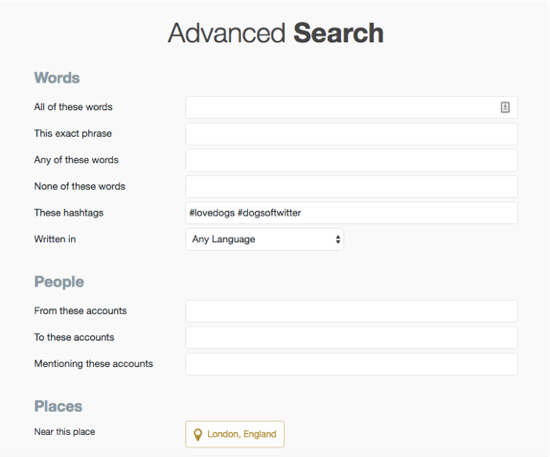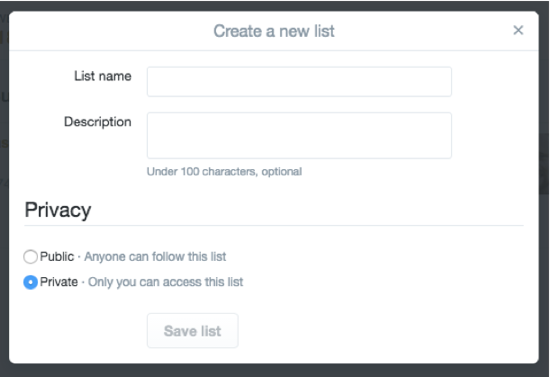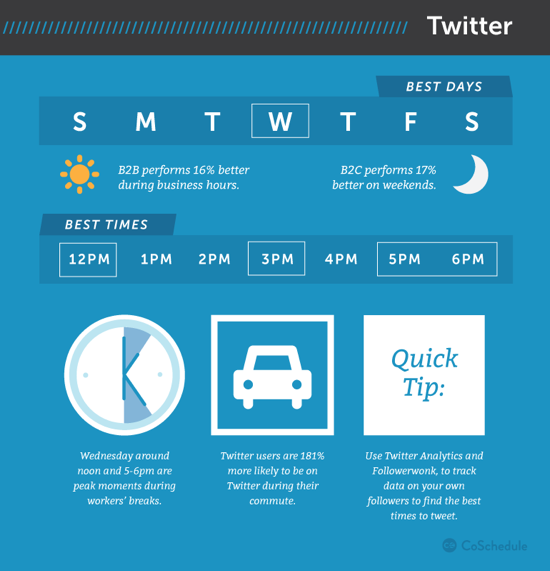Eight super-effective ways to get more followers on Twitter when you have no budget
Twitter can be a powerful tool for any business, when used correctly. It helps to generate leads and sales, to increase brand awareness and to build strong relationships with prospects. The trouble is, if you have no followers, you can’t experience all these benefits.
While it should never be about the number of followers you have on Twitter (or any other social network for that matter), if no one’s around to read and interact with your content, then what’s the point of being on Twitter?
Sure, most businesses gain their first tens of followers by asking employees, friends, family and current customers to follow them on Twitter. But what then? How else can a small business on a budget get more followers on Twitter? And we’re not referring to just any followers, but those are genuinely interested in your business and what you have to say.
In this post we’ll be covering a few techniques you can use to increase your Twitter following, without having to spend a pound on buying followers or running ad campaigns.
Share great content
One of the biggest mistakes that brands, big and small, make on Twitter is sharing the wrong content. Most brands are so focused on sharing lots and lots of content, that they forget who their audience is and what type of content they’re actually interested in.
Sure, it’s very important to create, find and share high quality content on Twitter. But it’s even more important for it to be relevant to your business and interesting for your audience.
So if you’re a plumber but you’re sharing (great) pieces about politics, the environment or sports, then 1. your target audience won’t have any good reason to follow you since that’s not the type of information they’re interested in or that they expect to find on your page and 2. you might be attracting the wrong audience, and when you do actually promote your business and products or services, no one will be interested.
That’s why initial research is so important, to help you determine who your target audience is on Twitter and what type of content they want to see.
There are two simple ways to find out more about your audience and what they’re interested in.
- Analyse your competitors’ Twitter activity
The first one is to look into your competitors’ social media activities to see what they’re doing online, what type of content they’re sharing, and who is interacting with them on various social networks.
Looking into what your competitors are doing on Twitter will help you to get a clearer picture on the type of content that your audience finds most interesting, as well as what your competition is doing to engage and build a loyal following.
When you gather your information, focus on:
- Type of content that they’re sharing: Are they sharing mostly links, video, photos or a combination of all? Do all their links includes photos? How many of their posts are actually articles from their blog? How often do their retweet others? Which sites do they get their content from?
- Engagement type:Record the number of Retweets, likes and replies.
- Time and day:When exactly was the tweet sent out? Do they also tweet on the weekends or only during the week?
- Copy:Write down the headline/copy of the tweet. Do they also include calls-to-action in their tweets? How often?
By taking a closer look at how they’re managing their Twitter accounts, you’ll be able to figure out not just what is working but also why it’s working. You might actually learn that your audience responds more to early in the morning tweets, or that they like infographics best.
- Check Twitter demographics
The second one is to reference this social media audience research and demographics to get a better understanding of who is spending time on Twitter. In it you’ll find lots of useful information on Twitter users, including data on gender, age, location, income, education and more.
Build relationships
Establishing connections and building relationships is one of the easiest ways to get more Twitter followers. But be prepared to invest a bit of time and effort.
You already have a list of people you can connect with from the competitive research you did earlier. If you want to find even more, you can try running an advanced search on Twitter.
Go to Twitter’s Advanced Search and run a search to find potential customers who would be interested in your business. Fill out the form with relevant keywords, hashtags and a specific location (if you’re a local business targeting local customers).
For example, a dog trainer in London could run a search using hashtags like #dogsoftwitter, #lovedogs or #petowner.
Your search will show you users who have used these tags and who can potentially be interested in your business. Add them to your list.
You can also use tools like Buzzsumo and TweetDeck to find more prospects.
Now you can create a private list on Twitter where you add all these prospects and start connecting with them.
To create a private list, click on your Twitter picture on the right corner -> Lists. Next click on Create new list and tick the “Private” option.
Aim to spend at least 30 minutes a day to engage with new people and get them to notice you and the great content that you’re sharing. Start by liking, replying or retweeting their tweets and see where that takes you. Just make sure you keep at it as you can’t expect to get results and significantly increase your Twitter following if you only do this once.
You can’t expect results if all you do it like someone’s tweet and never interact with them again. The goal here is to build meaningful connections with people so they’ll remember you.
Share content more frequently
On Twitter the more often you tweet, the more opportunities you gave to be seen. So consider increasing your tweeting frequency.
If you’re only updating your account one or two times a day, that might not be enough, especially when you’re trying to increase visibility in the feeds and get more followers. To make posting less time-consuming you can create a social media scheduling calendar and schedule your tweets ahead of time.
Just make sure to only share relevant and quality content as that’s more important than how often you tweet. There’s no point in sending 20 tweets a day if 15 are irrelevant and provide no real value to your audience. Not only will you not gain new followers, but you might also risk losing some of your currents ones.
Updating your Twitter account with great content as often as possible also lets people know that your account is active, and they will feel even more motivated to follow you. For more tips and advice, make sure to read our post on why and how to schedule social media posts.
Tweet on the weekends
Several studies have demonstrated the value of weekend Tweeting since audiences have more time to consume and share content.
Dan Zarella’s research, for example, showed that engagement is 17% higher on weekends than during the week. Of course, this is something you need to experiment with to see whether this is also true for your audience.
This infographic from CoSchedule shares some interesting data on the optimal times to tweet. Check it out and also read their in-depth post for more useful information on the best times to share content on Twitter (as well as other social media platforms).
Promote your profile
When you’re guest posting or publishing a press release it’s perfectly normal to want to add a link to your site as that can help your search engine optimisation efforts and can also send more visitors to your site.
However, if you’re looking to increase your Twitter following, consider linking to your Twitter profile once in a while instead of to your site.
For example, when you’re guest posting on other sites, add a link to your Twitter profile in the author section. Users who read your post and find it interesting will most likely want to follow you on Twitter so they can read more of your content. You can also your Twitter profile on other types of content you create like infographics, videos, and slides.
It goes without saying that you should have a link to your Twitter profile on your website and blog.
Mention your location
If you are a local business looking to attract more local customers, make sure you add your location in your Twitter profile. And here’s another cool thing you can do to get the attention of locals: mention your location in your tweets.
For example, say you’re a dog trainer and you’re out in the park, doing what you do best. You could tweet a picture and add a message like “At Arthur’s Seat, in @edinburgh, enjoying a lovely walk with my fun companions!”
Edinburgh’s Twitter will notice you have tagged them, and might retweet your post to all their 78.8K followers and also follow you. Of course, they might not but what have you got to lose?
So make sure to connect with city accounts, local businesses and news sources on Twitter, and mention them in your tweets whenever you get a chance. Most of them will be happy to follow you back and to share your tweets with their followers. This could translate to even more Twitter followers for your business.
Mention bloggers and influencers in your tweets
Since I’m a blogger myself, I know that getting recognition for a blog post feels awesome. With that in mind, when you’re sharing content from other blogs or even from big sites like Fast Company or the New York Times, make sure to mention individual authors in your tweets. This is a small effort which can pay off in Twitter followers.
You can do the same with users and influencers in your industry to get them to notice and follow you, and they may even retweet your content to their followers. Just make sure to only tag them when its relevant.
Watch these two Swift Six videos to learn more about how to:
Join or host Twitter chats
Chats are a great way to engage with your customers and prospects on a deeper level. Follow those you meet in the chat, and they’re likely to follow you back.
If you’re not familiar with Twitter chats, they’re basically public conversations on Twitter around a specific hashtag. This hashtag is unique and its helps people to follow the conversation and to join in. A Twitter chat makes for the perfect tool to connect people with the same interests.
If this is something you’d like to try, read this step-by-step guide to hosting or joining a Twitter chat for some useful tips and advice on how to get started and how to make the most of it.
Wrapping up
Getting more followers on Twitter is all about posting the helpful and relevant content and engaging with the right people. While this can take time, and you’ll have to keep at it in order to significantly grow your following, if you are patient and consistent it will be worth the effort.
After all, it’s not rocket science, and even small businesses with non-existent social media budgets can thrive by following these tips.
Your turn now: what else are you doing to increase your number of Twitter followers? Tweet us @123reg with your most effective techniques.




